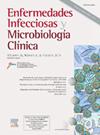Dalbavancin as sequential therapy in infective endocarditis: Real-life experience in elder and comorbid patients
IF 2.5
4区 医学
Q3 INFECTIOUS DISEASES
Enfermedades infecciosas y microbiologia clinica
Pub Date : 2025-02-01
DOI:10.1016/j.eimc.2024.04.009
引用次数: 0
Abstract
Objectives
This study aimed to evaluate the effectiveness of dalbavancin as sequential therapy in patients with infective endocarditis (IE) due to gram positive bacteria (GPB) in a real-life heterogenous cohort with comorbid patients.
Methods
A single center retrospective cohort study including all patients with definite IE treated with dalbavancin between January 2017 and February 2022 was developed. A 6-month follow-up was performed. The main outcomes were clinical cure rate, clinical and microbiological relapse, 6-month mortality, and adverse effects (AEs) rate.
Results
The study included 61 IE episodes. The median age was 78.5 years (interquartile range [IQR] 63.2–85.2), 78.7% were male, with a median Charlson comorbidity index of 7 (IQR 4–9) points. Overall, 49.2% suffered native valve IE. The most common microorganism was Staphylococcus aureus (26.3%) followed by Enterococcus faecalis (21.3%). The median duration of initial antimicrobial therapy and dalbavancin therapy were 27 (IQR 20–34) and 14 days (IQR 14–28) respectively. The total reduction of hospitalization was 1090 days. The most frequent dosage was 1500 mg of dalbavancin every 14 days (96.7%). An AE was detected in 8.2% of patients, only one (1.6%) was attributed to dalbavancin (infusion reaction). Clinical cure was achieved in 86.9% of patients. One patient (1.6%) with Enterococcus faecalis IE suffered relapse. The 6-month mortality was 11.5%, with only one IE-related death (1.6%).
Conclusion
This study shows a high efficacy of dalbavancin in a heterogeneous real-world cohort of IE patients, with an excellent safety profile. Dalbavancin allowed a substantial reduction of in-hospital length of stay.
达巴万星作为感染性心内膜炎的序贯疗法:老年患者和合并症患者的实际经验
目的:本研究旨在评估达巴文星作为序贯治疗革兰氏阳性菌(GPB)引起的感染性心内膜炎(IE)患者的有效性。方法采用单中心回顾性队列研究,纳入2017年1月至2022年2月期间接受达尔巴文星治疗的所有确诊IE患者。随访6个月。主要观察指标为临床治愈率、临床及微生物复发率、6个月死亡率和不良反应(ae)率。结果本研究包括61例IE发作。年龄中位数为78.5岁(四分位间距[IQR] 63.2 ~ 85.2),男性78.7%,Charlson共病指数中位数为7 (IQR 4 ~ 9)。总体而言,49.2%的患者患有先天性瓣膜IE。最常见的微生物是金黄色葡萄球菌(26.3%),其次是粪肠球菌(21.3%)。初始抗菌药物治疗和达尔巴文星治疗的中位持续时间分别为27天(IQR 20-34)和14天(IQR 14 - 28)。住院总天数减少1090天。最常见的剂量是每14天1500 mg(96.7%)。8.2%的患者检测到AE,只有1例(1.6%)归因于达尔巴万辛(输液反应)。临床治愈率达86.9%。粪肠球菌IE复发1例(1.6%)。6个月死亡率为11.5%,仅1例ie相关死亡(1.6%)。结论:该研究显示达巴文星在异质性IE患者队列中具有很高的疗效,并具有良好的安全性。达尔巴万辛允许大幅度缩短住院时间。
本文章由计算机程序翻译,如有差异,请以英文原文为准。
求助全文
约1分钟内获得全文
求助全文
来源期刊
CiteScore
2.10
自引率
8.00%
发文量
194
审稿时长
29 days
期刊介绍:
Hoy está universalmente reconocida la renovada y creciente importancia de la patología infecciosa: aparición de nuevos agentes patógenos, de cepas resistentes, de procesos con expresión clínica hasta ahora desconocida, de cuadros de una gran complejidad. Paralelamente, la Microbiología y la Infectología Clínicas han experimentado un gran desarrollo como respuesta al reto planteado por la actual patología infecciosa. Enfermedades Infecciosas y Microbiología Clínica es la Publicación Oficial de la Sociedad Española SEIMC. Cumple con la garantía científica de esta Sociedad, la doble función de difundir trabajos de investigación, tanto clínicos como microbiológicos, referidos a la patología infecciosa, y contribuye a la formación continuada de los interesados en aquella patología mediante artículos orientados a ese fin y elaborados por autores de la mayor calificación invitados por la revista.

 求助内容:
求助内容: 应助结果提醒方式:
应助结果提醒方式:


